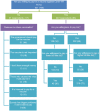Willingness to Pay for a COVID-19 Vaccine
- PMID: 33619688
- PMCID: PMC7899739
- DOI: 10.1007/s40258-021-00644-6
Willingness to Pay for a COVID-19 Vaccine
Abstract
Background: The coronavirus disease (COVID-19) pandemic has considerably affected the lives of people worldwide, impacting their health and economic welfare, and changing the behavior of our society significantly. This situation may lead to a strong incentive for people to buy a vaccine. Therefore, a relevant study to assess individuals' choices and the value of change in welfare from a COVID-19 vaccine is essential.
Objective: This study aimed to estimate the willingness-to-pay (WTP) value for a vaccine for COVID-19. We also identify the variables that influence individual vaccination decisions, which could be used in the design of vaccination promotion strategies.
Methods: We use the contingent valuation method in its double-bounded dichotomous choice format. The estimation coefficients are calculated according to the maximum likelihood method under the assumption of a probit distribution. The sample consisted of 531 individuals, mainly from middle- and high-income socioeconomic groups from Chile between enrolled between 10 July and 10 August 2020.
Results: The results show a high WTP for the COVID-19 vaccine, with a value up to US$232. Income and education levels and having family members with COVID-19 increased the likelihood of persons paying for a vaccine. There is also a greater fear as the pandemic progresses that people will get sick from COVID-19.
Conclusions: The high WTP value creates an opportunity for formulating public health policy. The results of this study suggest that governments can provide the vaccine free to low-income groups and allow those with higher incomes to acquire the vaccine through the private sector by paying. This will be useful especially for countries with economic difficulties.
Conflict of interest statement
The authors declare that there no conflicts of interest that are relevant to the contents of this article.
Figures


Comment in
-
Comment on: "Willingness to Pay for a COVID-19 Vaccine".Appl Health Econ Health Policy. 2021 Jul;19(4):619-621. doi: 10.1007/s40258-021-00656-2. Epub 2021 May 11. Appl Health Econ Health Policy. 2021. PMID: 33973148 Free PMC article. No abstract available.
References
-
- Acter T, Uddin N, Das J, Akhter A, Choudhury TR, Kim S. Evolution of severe acute respiratory syndrome coronavirus 2 (SARS-CoV-2) as coronavirus disease 2019 (COVID-19) pandemic: a global health emergency. Sci Total Environ. 2020;730:138996. doi: 10.1016/j.scitotenv.2020.138996. - DOI - PMC - PubMed
MeSH terms
Substances
LinkOut - more resources
Full Text Sources
Other Literature Sources
Medical

